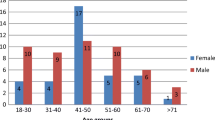Abstract
We aimed to evaluate the usefulness of morphometric measurements performed on cranial computerized tomography (CT) images for the estimation of sex. A retrospective study was performed in the radiology department of a tertiary care center using data collected from cranial CT scans of 616 Caucasian cases (307 women, 309 men) with an average age of 44.70 ± 16.43. The parameters under investigation consisted of maximum cranial length (MCL), minimum frontal breadth, bi-zygomatic breadth (BZB), parietal chord, maximum cranial breadth, bi-mastoid diameter (BIM) and the length of cranial base. Any statistically significant difference in terms of these parameters was found between males and females. In our series, women were remarkably older than men (47.56 ± 15.87 vs. 41.39 ± 16.43; p < 0.001). We observed that there was a statistically significant difference between males and females concerning all morphometric measurements and males displayed higher values in terms of all parameters (p < 0.001, for all). The variables with the most successful performance for discrimination of gender were BZB (89.2%), MCL (87.4%) and BIM (84.8%). The concomitant use of these morphometric measurements seems to improve the accuracy of sex estimation. We suggest that morphometric measurements performed on cranial CT images can be useful for the estimation of sex.








Similar content being viewed by others
References
Irurita Olivares J, Alemán AI (2017) Proposal of new regression formulae for the estimation of age in infant skeletal remains from the metric study of the pars basilaris. Int J Leg Med 131(3):781–788
Thompson TJU, Black SM (2007) Forensic human identification: an introduction. CRC Press, Boca Raton
Jensen RA (2017) Mass fatality and casualty incidents: a field guide. CRC Press, Boca Raton
Hines E, Rock C, Viner M (2007) Radiography. In: Thompson TJU, Black SM (eds) Forensic human identification: an introduction. CRC Press, Boca Raton, pp 221–228
Christensen AM, Passalacqua NV, Bartelink EJ (2013) Forensic anthropology: current methods and practice, 1st edn. Elsevier, San Diego
Carvalho SPM, Brito LM, de Paiva LAS, Bicudo LAR, Crosato EM, de Oliveira RN (2013) Validation of a physical anthropology methodology using mandibles for gender estimation in a Brazilian population. J Appl Oral Sci 21:358–362
Abtahi S, Phuong A, Major PW, Flores-Mir C (2018) Cranial base length in pediatric populations with sleep disordered breathing: a systematic review. Sleep Med Rev 39:164–173
Ekizoglu O, Hocaoglu E, Inci E, Can IO, Solmaz D, Aksoy S, Buran CF, Sayin I (2016) Assessment of sex in a modern Turkish population using cranial anthropometric parameters. Leg Med 21:45–52
Kerr WJ, Adams CP (1988) Cranial base and jaw relationship. Am J Phys Anthropol 77:213–220
Buikstra JE, Ubelaker DH (1994) Standards for data collection. In: Proceedings of a seminar at the field museum of natural history (Arkansas Archaeological Survey Research Series 44), Archeological Survey, Arkansas
Buran F, Can IO, Ekizoglu O, Balci A, Guleryuz H (2018) Estimation of age and sex from bimastoid breadth with 3D computed tomography. Rom J Leg Med 26:56–61
Gurses MS, Inanir NT, Soylu E, Gokalp G, Kir E, Fedakar R (2017) Evaluation of the ossification of the medial clavicle according to the Kellinghaus substage system in identifying the 18-year-old age limit in the estimation of forensic age—is it necessary? Int J Leg Med 131:585–592
Verhoff MA, Ramsthaler F, Krahahn J, Deml U, Gille RJ, Grabherr S et al (2008) Digital forensic osteology—possibilities in cooperation with the Virtopsy project. Forensic Sci Int 174:152–156
Thali MJ, Braun M, Buck U, Aghayev E, Jackowski C, Vock P et al (2005) VIRTOPSY—scientific documentation, reconstruction and animation in forensic: individual and real 3D data based geo-metric approach including optical body/object surface and radiological CT/MRI scanning. J Forensic Sci 50:428–442
Scheuer L (2002) Application of osteology to forensic medicine. Clin Anat 15:297–312
Alves N, Deana NF, Ceballos F, Hernandez P, Gonzalez J (2019) Sex prediction by metric and non-metric analysis of the hard palate and the pyriform aperture. Folia Morphol 78(1):137–144
Chiba M, Terazawa K (1998) Estimation of stature from somatometry of skull. Forensic Sci Int 97:87–92
Colman KL, de Boer HH, Dobbe JGG, Liberton NPTJ, Stull KE, van Eijnatten M et al (2019) Virtual forensic anthropology: the accuracy of osteometric analysis of 3D bone models derived from clinical computed tomography (CT) scans. Forensic Sci Int 304:109963
Schulte-Geers C, Obert M, Schilling RL, Harth S, Traupe H, Gizewski ER et al (2011) Age and gender-dependent bone density changes of the human skull disclosed by high-resolution flat-panel computed tomography. Int J Leg Med 125:417–425
Decker SJ, Davy-Jow SL, Ford JM, Hilbelink DR (2011) Virtual determination of sex: metric and nonmetric traits of the adult pelvis from 3D computed tomography models. J Forensic Sci 56(5):1107–1114
Franklin D, Flavel A, Kuliukas A, Cardini A, Marks MK, Oxnard C et al (2012) Estimation of sex from sternal measurements in a Western Australian population. Forensic Sci Int 217(1–3):230.e1–5
Franklin D, Cardini A, Flavel A, Kuliukas A, Marks MK, Hart R et al (2013) Concordance of traditional osteometric and volume-rendered MSCT interlandmark cranial measurements. Int J Leg Med 127(2):505–520
Acknowledgements
The authors declare no competing interest. No financial support was received for this paper.
Author information
Authors and Affiliations
Corresponding author
Ethics declarations
Conflict of interest
The authors declare that they have no conflict of interest.
Ethical approval
This study is a retrospective study. Ethical approval is not required dependent on the law and the national ethical guidelines in our country.
Informed consent
Informed consent was obtained from all individual participants included in the study. Identifying information about participants is not available in the article.
Additional information
Publisher's Note
Springer Nature remains neutral with regard to jurisdictional claims in published maps and institutional affiliations.
Rights and permissions
About this article
Cite this article
Cekdemir, Y.E., Mutlu, U., Karaman, G. et al. Estimation of sex using morphometric measurements performed on cranial computerized tomography scans. Radiol med 126, 306–315 (2021). https://doi.org/10.1007/s11547-020-01233-8
Received:
Accepted:
Published:
Issue Date:
DOI: https://doi.org/10.1007/s11547-020-01233-8




